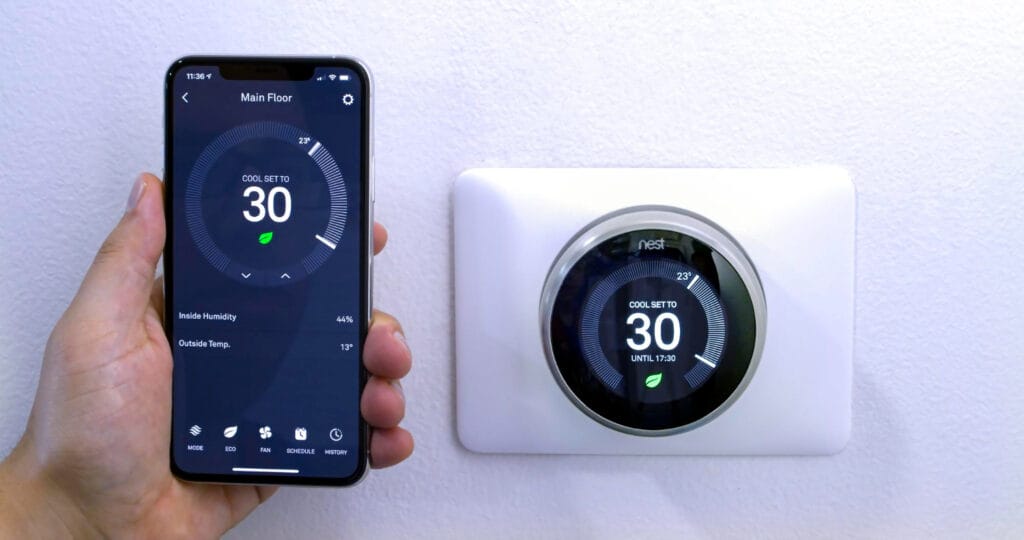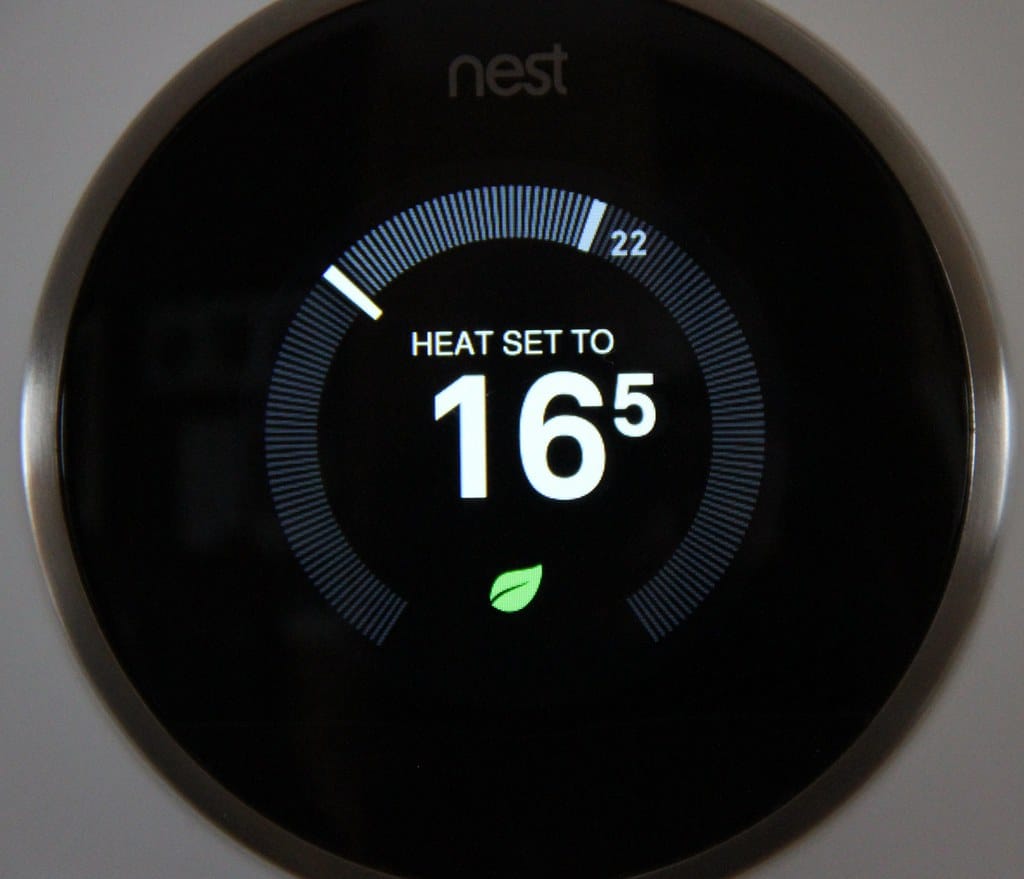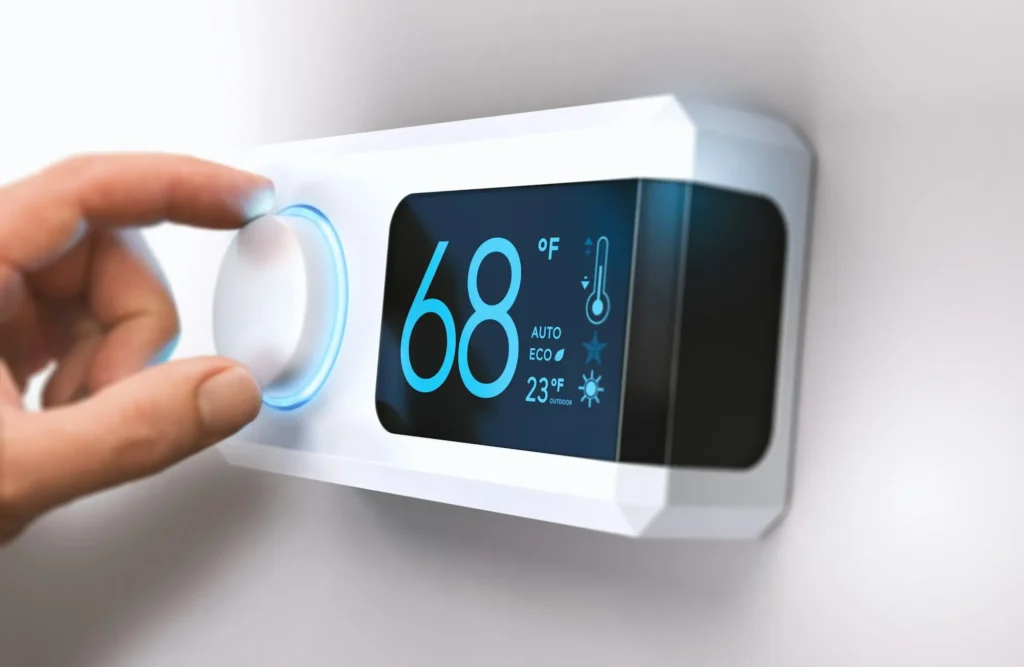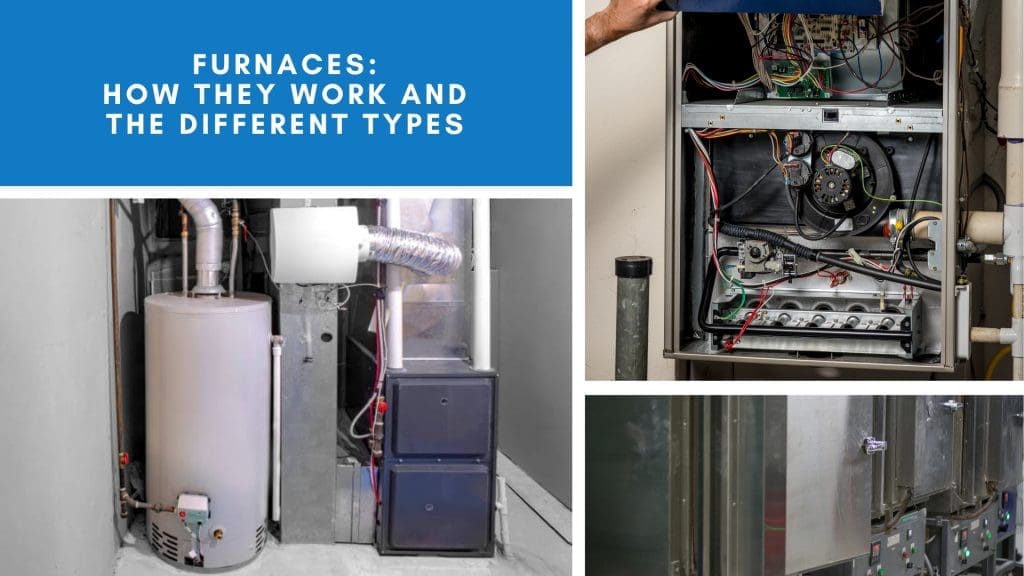When it comes to maintaining a comfortable home environment, your thermostat plays a crucial role. It’s the control center of your heating and cooling system, helping to ensure optimal temperatures throughout the year.
But what happens when your thermostat starts acting up?
You might notice inconsistent temperatures or unresponsive controls. Perhaps your HVAC system is cycling on and off more frequently than usual. These are signs that you might need a new thermostat.
But how often should you replace your thermostat?

The answer can vary, but generally, a thermostat should be replaced every 10 years. However, with advancements in technology, many homeowners are choosing to upgrade sooner.
Why?
The answer lies in the benefits of smart thermostats. These high-tech devices offer significant energy savings, especially during the hot summer months. They learn your schedule, adjust temperatures accordingly, and can even be controlled remotely via Wi-Fi.
In this guide, we’ll explore the signs that indicate you need a new thermostat, the benefits of upgrading to a smart thermostat, and how such an upgrade can keep your bills down in summer. Whether you’re a small business owner, a work-from-home professional, or a busy stay-at-home mom, this information will help you make informed decisions about your home’s HVAC system.
So, let’s dive in and learn more about the world of thermostats.
Recognizing the Signs: Do You Need a New Thermostat?
Knowing when to replace your thermostat can be tricky. Many folks miss the signs at first because they seem minor. Yet, over time, they can lead to bigger issues.
Is your home not as comfortable as it used to be? Inconsistent temperatures or unresponsive controls might be to blame. These hiccups are often overlooked but signal potential thermostat trouble.
Your HVAC system may be working overtime. If your system cycles on and off frequently, your thermostat could be malfunctioning. This excess cycling stresses your system and spikes your energy bills.
Watch out for these key symptoms:
- Temperature inconsistencies throughout the house.
- An unresponsive or malfunctioning touch screen.
- The HVAC system cycles frequently or won’t stop running.
- The thermostat display is blank or shows errors.
Older thermostats tend to develop such issues more often. Regular maintenance can prolong their life, but eventually, replacement becomes necessary.
Next, we’ll explore specific scenarios pointing to the need for a new thermostat. Addressing these issues promptly ensures your comfort while curbing unnecessary energy expenses.

Inconsistent Temperatures and Unresponsive Controls
A reliable thermostat delivers consistent indoor temperatures. If you’re experiencing hot and cold spots, it may not be functioning optimally. These temperature variances make it uncomfortable to move around in your home.
Unresponsive controls are another red flag. If it doesn’t respond when you adjust the thermostat, it’s time for a closer inspection. This lack of responsiveness can stem from worn out components or internal faults.
These issues impact comfort and efficiency. A new thermostat, especially a smart model, can solve these problems. Upgrading ensures steady temperatures and responsive controls with modern features.
Frequent Cycling and Other Malfunctions
Frequent HVAC cycling is more than just a nuisance. It signals potential issues with your thermostat’s wiring or settings. Constant cycling also leads to wear and tear, shortening your HVAC system’s lifespan.
Malfunctions may take many forms. Your system might blow hot air instead of cool, or vice versa. Such mismatches often arise from incorrect thermostat settings or wiring errors.
Ignoring these problems isn’t wise. They cause energy inefficiency, raising your bills without enhancing comfort. Replacing your old thermostat can address these malfunctions swiftly. Newer thermostats also bring tech upgrades and energy savings. Looking to the future, these upgrades contribute to a more eco-friendly home.
The Lifespan of a Thermostat: When to Consider a Replacement
Thermostats don’t last forever. As they age, you may notice subtle declines in performance. Recognizing this can help you avoid more serious HVAC issues.
On average, a thermostat’s lifespan is about 10 years. Technological advancements offer smarter options to enhance efficiency. Thus, considering an upgrade earlier could be beneficial.
So, when should you replace your thermostat? Here’s a checklist to guide your decision:
- Persistent temperature inconsistencies.
- Visible wear and tear or outdated technology.
- Frequent malfunctions impacting your HVAC system.
- Rising energy bills without an increase in usage.
Each of these signs suggests it might be time to consider a new thermostat. Doing so can improve comfort and efficiency significantly.
How Often Should You Replace Your Thermostat?
The general rule is to consider replacement every 10 years. Over a decade, even the most reliable thermostat can start showing signs of age. Yet, if you spot recurring issues sooner, an earlier replacement is wise.
Staying ahead of problems saves you from unexpected heating or cooling failures. Plus, newer thermostats promise improved energy savings, making them a smart investment.
Factors Affecting Thermostat Longevity
Longevity varies among thermostats. Some key factors include maintenance, environmental conditions, and technology type. Regular maintenance can extend lifespan significantly.
Advanced digital and smart thermostats tend to outlast older models. They’re built to endure more wear and tear and have easier updates. Environmental elements like dust and humidity also affect lifespan. Keeping your home’s climate steady helps prolong a thermostat’s operational life.
Smart Thermostats: Maximizing Comfort and Minimizing Costs
Smart thermostats are revolutionizing how we manage home energy use. They offer sophisticated features designed for better control over your HVAC system. Let’s delve into how they can enhance both comfort and cost-efficiency.
A smart thermostat learns your household patterns. By doing this, it adjusts temperatures to suit your schedule. This means less wasted energy and improved comfort.
Consider these key perks of installing a smart thermostat:
- Programmable schedules that match your daily routines.
- Remote access via smartphone apps for on-the-go management.
- Detailed energy reports for better efficiency insights.
Switching to a smart thermostat can cut your energy bills significantly. It’s a small change with big benefits for both your wallet and the environment.
The Energy-Saving Benefits of Smart Thermostats
Smart thermostats are specifically designed to conserve energy. They adjust heating and cooling based on real-time data and historical usage. This adaptation minimizes the unnecessary energy consumption typical of older systems.
Imagine reducing your energy consumption without even thinking about it. That’s the convenience a smart thermostat provides. It optimizes your system’s performance while ensuring you never sacrifice comfort.
Many users report savings of up to 10% annually on their energy bills. This makes smart thermostats a financially wise choice. Simply put, they help pay for themselves over time.
Smart Features That Cut Down on Summer Bills
Summer brings high temperatures and, often, high energy bills. Smart thermostats offer features that combat this effectively. Geofencing, for example, adjusts your settings when you’re away, automatically turning up the air conditioning as you return.
The capability to integrate with smart home devices adds another layer of convenience and efficiency. These thermostats synchronize with other devices to optimize energy usage throughout your home.
Moreover, smart thermostats provide alerts and maintenance reminders. They notify you of potential efficiency issues in your HVAC system. With timely interventions, you can prevent larger, costlier problems. In short, these thermostats help keep your cool without the stress of high bills.
Choosing the Right Thermostat: Reviews and Comparisons
Choosing the right thermostat involves understanding your specific needs. Reviews and comparisons can provide valuable insights. They help you evaluate options and make informed decisions.
Thermostat technologies vary widely. It’s essential to consider features that align with your lifestyle. Whether you prefer simple controls or advanced smart capabilities, there’s a thermostat for you.
Some thermostats offer programmable settings, while others come with smart technology features. Check customer reviews to understand reliability and functionality. Real-world feedback can be revealing.
When making a decision, consider the range of features different models offer. Here’s what to keep in mind:
- Ease of use: Intuitive interfaces make operation simple.
- Connectivity: Wi-Fi and smartphone integration for remote access.
- Compatibility: Ensure the thermostat works with your existing HVAC system.
- Energy reporting: Some models provide detailed usage insights.
Researching and comparing thermostats is key to maximizing your investment. Opt for a balance between modern features and straightforward usability.
What to Look for in Thermostat Features
When selecting a thermostat, prioritizing features is vital. Different homes have different requirements. What works for one might not work for another.
Look for energy-saving features. These can make a big difference in utility costs over time. Programmable options let you set heating and cooling schedules, saving energy during off-peak times.
Wi-Fi connectivity is another feature to consider. This allows for remote operation and easy adjustments from anywhere. For tech-savvy users, compatibility with voice assistants is a plus.
It’s also wise to consider installation complexity. Some thermostats are better suited for professional installation. Understanding these features ensures you choose a model that fits your needs and capabilities.
Top-Rated Thermostats and Customer Feedback
Exploring top-rated thermostats can point you in the right direction. Many customers prefer models from reliable brands like Honeywell, Nest, and Ecobee. These brands are well-regarded for innovation and reliability.
Customer feedback often highlights ease of use and energy savings. Common praises also include intuitive interfaces and helpful support. Dissatisfied reviews usually discuss issues with compatibility or connectivity, so pay attention to these details.
Before purchasing, compare features, prices, and brand reputation. Customer reviews can be particularly informative. They provide a glimpse into real-life experiences, helping to avoid potential pitfalls.
In summary, well-researched decisions can lead to a satisfying thermostat purchase. Emphasize models that are highly regarded by both users and experts. Ensure that your choice elevates both comfort and energy efficiency in your home.
Installation and Compatibility: Ensuring Your New Thermostat Works Flawlessly
Installing a new thermostat can seem daunting. Yet, it’s crucial to ensure everything functions smoothly. Whether you’re doing it yourself or hiring a pro, proper installation is key.
Mistakes during installation can lead to issues like incorrect temperatures. This not only affects comfort but can also drive up energy bills. Here’s what you need to consider:
- Type of thermostat: Is it mechanical, digital, or smart?
- Wiring needs: Does your system require C-wire or other specific connectors?
- Positioning: Is the thermostat placed in an optimal spot, away from drafts and direct sunlight?
- Initial setup: Have you inputted the correct settings for energy efficiency?
Flawless installation involves verifying compatibility with your HVAC system. It avoids costly errors and ensures the thermostat performs optimally.
Professional Installation vs. DIY: What You Need to Know
Choosing between DIY and professional installation depends on your confidence and skill level. DIY can save money, but it requires understanding wiring and setup.
Professional installation, while more costly, offers peace of mind. Professionals ensure proper wiring and setup, reducing the risk of malfunctions. For those less familiar with electrical work, this can be a safer option.
Compatibility with Your HVAC System
Compatibility with your existing HVAC system is essential for your thermostat to function correctly. Different systems have varying requirements in terms of wiring and voltage.
Before purchasing a thermostat, check your HVAC system’s compatibility. This ensures seamless integration and optimal performance.
Consult your HVAC system’s manual or an expert if you’re unsure. Addressing compatibility concerns beforehand prevents future headaches and guarantees efficient system operation.
Troubleshooting Common Thermostat Issues
Even new thermostats can encounter issues. Luckily, many problems are easily fixed. Addressing these issues promptly ensures comfort and efficiency.
Common thermostat problems include unexpected battery warnings, incorrect temperature readings, and unresponsive controls. These issues can stem from setup errors or internal faults.
To help you troubleshoot, consider these pointers:
- Ensure batteries are installed correctly and replace them if needed.
- Check thermostat settings and ensure they match your preferences.
- Verify wiring connections to prevent faulty reading.
For more persistent or complex issues, reaching out to a professional may be necessary.
Quick Fixes for Low Battery Warnings and Incorrect Temperatures
A low battery warning on a new thermostat is frustrating. Often, it’s a simple fix. Start by ensuring batteries are fresh and installed correctly.
If the issue persists, inspect battery contacts for corrosion. Cleaning them can resolve the warning. Incorrect temperature readings can also stem from calibration issues. Access your thermostat’s settings to recalibrate.
Simple steps can resolve most minor issues, restoring your system’s efficiency.
When to Call the Professionals: LC Heating and Air Conditioning
Some thermostat issues warrant expert help. If you notice frequent malfunctions or persistent issues, it’s time to call in the pros.
LC Heating and Air Conditioning offer expert diagnosis and repair. Their skilled technicians ensure your system runs smoothly. For those who prefer to avoid DIY, professional service saves time and hassle.
Count on LC Heating and Air Conditioning for reliable assistance with complex thermostat problems.
Embracing Smart Home Technology: The Future of Home Climate Control
The world of smart home technology is rapidly evolving. Thermostats are at the forefront, bridging comfort and innovation. These devices are no longer just about setting temperatures.
Smart thermostats offer energy-efficient solutions. They adjust settings based on real-time data, ensuring your home remains comfortable. The cost-saving benefits are evident, particularly during peak summer months.

Moreover, these devices work seamlessly with other smart home systems. Integration enhances user convenience, as everything syncs effortlessly. Upgrading to a smart thermostat is a step toward the future of home automation.
The Role of Thermostats in Home Automation
Thermostats are key players in home automation. They control the temperature and integrate with other systems. This ensures your home environment adapts to your needs automatically.
By monitoring usage patterns, these devices make real-time decisions. This ability highlights their crucial role in comprehensive automation. It’s all about enhancing comfort with minimal effort.
How Smart Thermostats Integrate with Other Devices
Smart thermostats connect easily with various devices. They sync with systems like smart lighting and security setups. The connection is often wireless and effortless.
This integration allows for centralized control. Adjusting your home’s environment can be done with a smartphone. It exemplifies the harmony between technology and daily living, making life both easier and more energy-efficient.
Conclusion: Enhancing Comfort and Efficiency with the Right Thermostat
Choosing the right thermostat can dramatically improve your home’s comfort and efficiency. Whether it’s a smart model or a reliable digital option, the right choice makes a difference. Your thermostat is the central tool in managing energy consumption.
Replacing an outdated thermostat can lower energy bills and enhance home comfort. Prioritizing energy-efficient models keeps your home eco-friendly. Upgrading is not just a luxury; it’s a practical step for modern living.
The Bottom Line on Upgrading Your Thermostat
Upgrading your thermostat is an investment in comfort and savings. It simplifies energy management, offering convenience and cost-effectiveness.
Contact LC Heating and Air Conditioning for Expert Advice
For help with choosing the right thermostat, trust LC Heating and Air Conditioning. Our expertise ensures you get advice tailored to your needs.
[CTA_contact_information]
Reach out to LC Heating and Air Conditioning today. Call us at (818) 858-7080 or visit lahvaclc.com. Discover how we can enhance your home comfort and efficiency.


